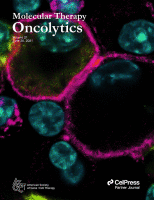|
Autors/es
Hill, Claudia; Grundy, Megan; Bau, Luca; Wallington, Sheena; Balkaran, Joel; Ramos, Victor ; Fisher, Kerry; Seymour, Len; Coussios, Constantin; Carlisle, Robert ; Fisher, Kerry; Seymour, Len; Coussios, Constantin; Carlisle, Robert
|
Abstract
Vaccinia virus (VV) is a powerful tool for cancer treatment with the potential for tumor tropism, efficient cell-to-cell spread, rapid replication in cancer cells, and stimulation of anti-tumor immunity. It has a well-defined safety profile and is being assessed in late-stage clinical trials. However, VV clinical utility is limited by rapid bloodstream neutralization and poor penetration into tumors. These factors have often restricted its route of delivery to intratumoral or intrahepatic artery injection and may impede repeat dosing. Chemical stealthing improves the pharmacokinetics of non-enveloped viruses, but it has not yet been applied to enveloped viruses such as VV. In the present study, amphiphilic polymer was used to coat VV, leading to reduced binding of a neutralizing anti-VV antibody (81.8% of polymer-coated VV [PCVV] staining positive versus 97.1% of VV [p = 0.0038]). Attachment of anti-mucin-1 (aMUC1) targeting antibody, to give aMUC1-PCVV, enabled binding of the construct to MUC1. In high MUC1 expressing CAPAN-2 cells, infection with PCVV was reduced compared to VV, while infection was restored with aMUC1-PCVV. Pharmacokinetics of aMUC1-PCVV, PCVV, and VV were evaluated. After intravenous (i.v.) injection of 1 × 108 viral genomes (VG) or 5 × 108 VG, circulation time for PCVV and aMUC1-PCVV was increased, with ~5-fold higher circulating dose at 5 min versus VV.
|

WoS
Scopus
Altmetrics

|
